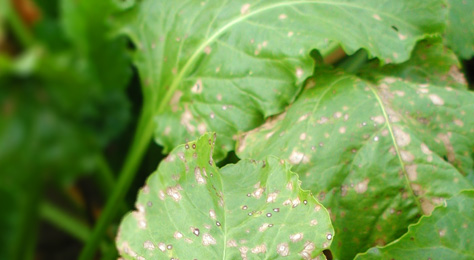A part of the bougainvillea’s appeal is that they are relatively disease and pest-free plants. It is NOT common for your bougainvillea to be affected by these pests and diseases if you follow BGI’s Rules for Care, and fertilize with Bougain® which contain a significant amount of micronutrients – vital for healthy, blooming bougainvillea. This page contains most (but not all) common pests/diseases that may affect your bougainvillea.
On the rare occurrences that your bougainvillea experiences pest problems or disease, always try the least toxic method of pest control as your first step. If you use chemical pesticides to control insect pests, you will also kill natural predators. If you choose a chemical control, follow directions and guidelines closely and always wear protective clothing and safety gear including a long-sleeved shirt, long pants, neoprene gloves, goggles and a respirator. Chemical pesticides are not recommended for use inside the home.
Aphids
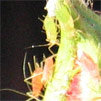 |
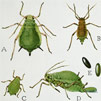 |
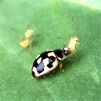 |
Known also as greenfly, blackfly or plant lice, aphids are minute plant-feeding insects. Important natural enemies include the predatory ladybugs/ladybirds/ladybeetles, and lacewings. Aphids are tiny, pear-shaped, sap-sucking pests, appearing in the spring to feast on your plants’ tender new leaves. They leave behind a secretion that attracts ants and promotes mold growth. Not to fear; you don’t have to resort to toxic chemicals to save your bougainvillea.
Natural Control
- Examine your garden regularly for signs of aphids. Look for clusters of the little bugs on new growth as well as on the curled and twisted leaves.
- While wearing gloves, remove the aphids by hand, or use a sharp stream of water to knock them off the plant.
- Cut away and dispose of infested foliage.
- Capture flying aphids by placing yellow sticky traps near infected plants.
- Make a nontoxic pesticide by mixing 1 cup vegetable oil with 1 tablespoon liquid dish-washing soap. Add 1½ teaspoon solution per cup of warm water to a handheld spray bottle.
- Hit the aphids directly with above mixture and spray entire plant thoroughly.
- Introduce beneficial insects, such as ladybugs/ladybirds/ladybeetles, or green lacewings to your garden to feed on the aphids. Both can be bought from garden stores or online.
- Avoid planting bougainvillea near aphid-attracting plants, such as birch trees, and instead grow plants such as white sweet clover, spearmint, sweet fennel and Queen Anne’s lace, which attract and house the lacewings, ladybugs and other insects that feed on aphids.
- Rid your garden of ants. Ants love to eat the sugary sap (honeydew) secreted by aphids, and will “farm” the aphids, protecting them on the plant they eat.
Caterpillars; namely the Bougainvillea Looper Caterpillar
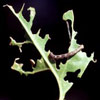 |
 |
The bougainvillea looper is a green or brown caterpillar about 1 inch long. It is also called inchworm or measuring worm. The looper larva mimics stems and branches very well and feeds primarily at night, which is why you may see the damage but fail to find the culprit on the plant. The adult is a moth, a very fast flyer with a wingspan of about 1 inch. The moth does not feed on the foliage. Like the larva, it also is active at night, when it is believed to lay its eggs on the underside of bougainvillea leaves. Go out scouting very early in the morning or at night if you have a good strong flashlight. The bougainvillea looper feeds from the edges of the leaves, which results in severe scalloping of the foliage. Attacks begin on the young tender shoots and leaves before progressing down the stem. The insect will cause significant visual damage to bougainvillea, although this does not apparently result in the death of the plants.
Chemical Control
Bacillus thuringiensis (BT, or Dipel®) and neem-based biological insecticide products should are a good solution and should be effective on the loopers without harming other insects that may biologically control them. Insectical oils and soaps will not control caterpillars such as the looper. Most synthetic insecticides with labels permitting use against caterpillars on landscape ornamentals, such as carbaryl (Sevin®), will likely kill the bougainvillea looper, although these products are often destructive to beneficial insects as well. Spraying insecticides late in the evening is recommended. This is when the bougainvillea looper caterpillars and adult moths are active, and also when the beneficial insects are not likely to be active.
Leafminers: Moths, Flies, Beetles, Wasps
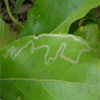 |
|---|
The vast majority of leaf-mining insects are moths (Lepidoptera) and flies (Diptera), though some beetles and wasps also exhibit this behavior. Although the types of insects differ, the damage they cause is very similar. Because of this, the larval stages of all insects which leaf mine are collectively and generically called “leaf miners”. All leaf miners will cause the leaves to look skeletonized, and to fall from the plant. Eventually they can kill the plant.
Natural Control
Cleaning around the plant is your best solution. Like wood borers, leaf miners are difficult to control as they are protected from insecticide sprays and plant defenses by feeding within the tissues of the leaves themselves. Some leaf miners can be killed by systemic pesticides (a type of pesticide that moves inside a plant following absorption by the plant), but many breeds are still immune to the effects of pesticide.
- Cleaning around the plants. Debris tends to collect at the base of plants, and this is where the adults of the leaf miner larvae lay their eggs. Some leaf mining larva may also “winter over” in this debris. Removing leaves and other debris from around plants is an excellent method for controlling them.
- Weeding provides an alternate food source for leaf miners, so areas around plants should be weeded and mulched.
- Do not use contact pesticides. Since the leaf miner is inside the leaf, contact poisons cannot reach it, and therefore cannot kill it. Additionally, leaf mining insect larvae quickly become resistant to contact pesticides.
Scale Insects: Parasites, Mealybugs
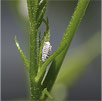 |
|---|
Most scale insects are parasites of plants, feeding on sap drawn directly from the plant’s vascular system. Scale insects vary dramatically in their appearance from very small organisms (1-2 mm) that occur under wax covers (some look like oyster shells), to shiny pearl-like objects (about 5 mm), to creatures covered with mealy wax. Scale insects’ waxy covering makes them quite resistant to pesticides, which are only effective against the juvenile crawler stage. Over time, scales and mealybugs turn leaves black with “sooty mold”.
Natural Control
- Identify scale insects by looking on the undersides of leaves and around leaf joints. Scale-damaged plants look withered and sickly and may have sticky sap or a black fungus on the leaves and stems.
- Move an infested plant to isolate it from the rest of your collection. Scale insects are invasive and will infest other plants.
- Remove scale insects with a twig or scraping tool. They will scrape off of plant tissue easily.
- Wash infested plants with a soap/oil mixture if scraping alone doesn’t do the job. Mix ½ tsp. insecticidal soap, ¼ tsp. horticultural oil into 1 quart of warm water. Wash the leaves individually with the soap/oil mixture. Rinse well. There are also numerous chemical products available for the control of mealybugs.
- Purchase and release a natural predator called Chilocorus nigritus or Lindorus lophanthae for serious infestations. Place the insects directly on the infested plant. Once they have consumed the scale, the predators will simply die from lack of food in the indoor environment.
- Spray with pyrethrin as a last resort. Pyrethrin is an organic pesticide made from chrysanthemums.
- Be diligent – examine infested plants for evidence of new scale every day. It may take some time, but your bougainvillea will thank you!
Snails & Slugs
Photo Credit: Weidners’ Gardens. Encinitas, California, Jeffrey Lotz; FDACS-DPI and David Robinson.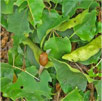 |
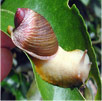 |
|---|
Snails usually eat from the middle of the leaf, but they can take bites out the edges as well. All this biting and chomping will make the leaf look scalloped. Putting down barriers that slugs can’t cross is, perhaps, the best way to protect your garden from these common pests. Keep them from entering and you won’t have to use pesticides.
Natural Control
- Water your garden only in the early morning, or use an underground irrigation pipe. This will keep the top of the soil dry and uninviting to slugs and snails.
- Spread dry soot, dry ashes, dry lime, sharp cinders and dry chalk around plants or beds. Any one of these or several in combination should do the trick.
- Rough, sharp sand is another option. Use it the same way as the materials in Step 2.
- Try calcified seaweed or crushed eggshells as a barrier.
- Another barrier material is clippings from thorny roses or holly leaves. Rosa rugosa (Japanese rose) clippings are good.
- Spread pine needles in your garden (these are also good mulch for strawberries).
- Spread chopped hair (human hair is fine) in your garden.
- Try using oak leaves as a barrier. Slugs and snails don’t like the tannin in the leaves.
Chemical Control
Any brand of slug/snail killer will do the job. Sluggo is good because it can be used around pets and people.
Mites; namely Spider Mites
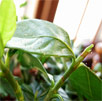 |
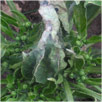 |
|---|
The webspinning two-spotted spider mite occasionally makes their home on bougainvillea. To the naked eye, spider mites look like tiny moving dots. Adult females, the largest forms, are less than 1/20 inch long. Spider mites live in colonies, mostly on the under-surfaces of leaves. The names “spider mite” and “webspinning mite” come from the silk webbing most species produce on infested leaves. The presence of webbing is an easy way to distinguish them from all other types of mites. Mites cause damage by sucking cell contents from leaves. A small number of mites is not usually reason for concern, but very high populations—levels high enough to show visible damage to leaves—can be damaging to plants. At first, the damage shows up as a stippling of light dots on the leaves; sometimes the leaves take on a bronze color. As feeding continues, the leaves turn yellow and drop off. Often leaves, twigs, and fruit are covered with large amounts of webbing. Damage is usually worse when compounded by water stress. Check the undersides of leaves for mites, their eggs, and webbing; you will need a hand lens to identify them. To observe them more closely, shake a few off the leaf surface onto a white sheet of paper. Once disturbed, they will move around rapidly. Be sure mites are present before you treat. Sometimes the mites will be gone by the time you notice the damage; plants will often recover after mites have left.
Natural Control
If a treatment for mites is necessary, use selective materials, preferably insecticidal soap or insecticidal oil. Petroleum-based horticultural oils or neem oils are both acceptable. Oils and soaps must contact mites to kill them so excellent coverage, especially on the undersides of leaves, is essential and repeat applications may be required. Mid-season washing with water to remove dust may help prevent serious late-season mite infestations. Regular, forceful spraying of plants with water will often reduce spider mite numbers adequately. Be sure to get good coverage, especially on the undersides of leaves.
Chemical Contol
Spider mites frequently become a problem after the application of insecticides. Such outbreaks are commonly a result of the insecticide killing off the natural enemies of the mites, but also occur when certain insecticides stimulate mite reproduction. Naturally controlling mites is the best method.
Thrips
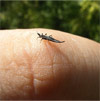 |
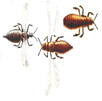 |
|---|
Thrips are tiny, slender insects with fringed wings that cause discoloration and deformities on bougainvillea and other plants. Other common names for thrips include thunderflies, thunderbugs, storm flies and corn lice. Thrips are generally tiny (1 mm long or less) and are not good flyers, although they can be carried long distances by the wind. Thrips feed by piercing plant cells with their paired maxillary stylets, which form a feeding tube. Due to their small size, cryptophilic behavior, and high rate of reproduction, thrips are difficult to control using classical biological control. Only two families of parasitoid hymenoptera are known to hunt them, the Eulophidae and the Trichogrammatidae.
Whitefly
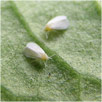 |
|---|
Whiteflies typically feed on the underside of plant leaves. Whiteflies feed by tapping into the phloem of plants, exposing plants to the whiteflies’ toxic saliva and decreasing the plant’s overall turgor pressure. The damage is quickly elevated as whiteflies congregate in large numbers, quickly overwhelming susceptible plants. Damage is further exacerbated as whiteflies, like aphids, excrete honeydew as a waste product, which promotes mold growth. Whitefly control is difficult and complex, as they rapidly gain resistance to chemical pesticides. A major problem is the fact that the whiteflies and the viruses they carry can infect many different host plants. Use of yellow sticky traps to monitor infestations and only selective use of insecticides is advised.
Common Diseases & Problems
Fungal and Bacterial Leaf Spot (Pseudomonas and ropogonis)
The early symptoms are small reddish-brown leaf spots which usually occur on younger foliage, and cause the leaves to look “rusty”. These enlarge into circular or irregular dark necrotic spots. When environmental conditions are drier and less favorable, leaf spots are slower to develop. Lesions have a tan center surrounded by a dark redbrown margin, and are sometimes bordered by a chlorotic halo. In time, leaf edges may become ragged as the necrotic tissue turns dry and papery. Under conditions of high rainfall or relative humidity the lesions develop quickly and are often black and vein delimited.
Infection of developing leaves and bracts results in puckered, distorted growth.
Defoliation will occur when leaf spotting, blighting or marginal necrosis becomes severe.
Natural Control
Maintaining dry foliage is the primary control measure. Prune branches back and away from each other or, if just starting to grow, allow a large amount of space between them. Branches that are overlapping can’t dry quickly and become more susceptible to leaf spot disease. Remove infected leaves and/or plants from the growing area.
Dispose of them immediately to reduce the spreading of infection.
Chemical Control
Spray fungicide in the spring if necessary. It will not cure infection that is already there, but it can control the spread of it. In frost-free climates where bougainvillea is perennial, disease incidence drops during cool and/or dry weather.
Black, Sooty Mold
See “Aphids”, “Scale Insects: Parasites, Mealybugs”, and “Whiteflies”
Leaf drop
Problem as a result of over-watering, under-watering, low light levels, or cold temperatures.
Leaf spots
Yellow or tan spots appear on older leaves may be sign of Magnesium deficiency (common with yellow bougainvillea varieties), or from over-watering.
Root rot
Plants that are over-watered or subjected to water logged conditions can develop root or stem rot. It’s easily prevented by careful handling and by the application of a broad spectrum fungicide drench during transplanting or planting in the landscape.
Scalloped Leaves a.k.a. “Help, Something’s Eating My Bougainvillea!”
See “Snails & Slugs” and “Bougainvillea Looper Caterpillar”
Yellowing or chlorosis on new growth
Often a result of a magnesium or iron deficiency, and an application of a complete micronutrient blend should help, but use caution–too much of either Mn or Fe will result in a secondary deficiency, as the plant is unable to absorb one when the other is present at high levels.
Yellowing or chlorosis on old growth
Often a result of a magnesium or iron deficiency. Apply Epsom salts at 1-2 tsp/gal as a drench or foliar spray.
Deficiency signs
[wwcAmzAffProducts asin=”B00CQ5GH1S”][/wwcAmzAffProducts]
Nitrogen deficiency: Older leaves turn a pale green and the veins are usually a reddish color. New growth will be stunted.
Phosphorus deficiency: The veins will turn red to purple and the plant as a whole will look purplish.
Potassium deficiency: Causes the edges of older the leaves to be a purple color and the leaf tips will be a brownish color.
Magnesium deficiency: First appears on older leaves where they turn a spotted yellow or tan color.
Zinc deficiency (rare): Will look almost like magnesium but here the leaf will be twisted.
Iron deficiency: Young growth is stunted and pale — you’ll know its iron if the veins on the leaf remain green.
Calcium deficiency: Dead areas appear in young growth and the tips soon die.


